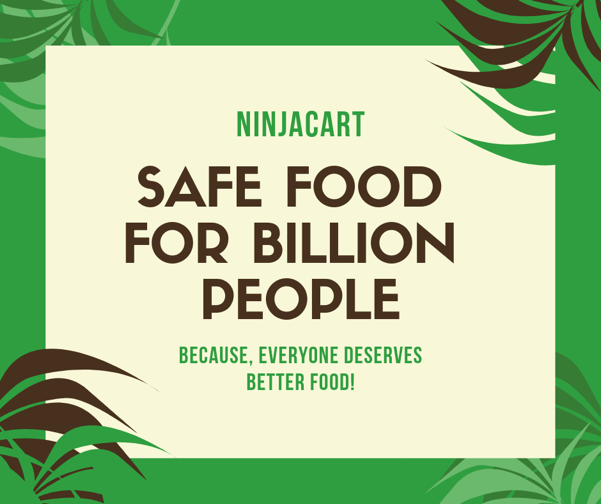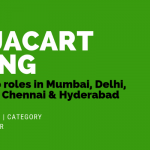Defining our Purpose
Table Of Content

Well, we screwed it!
Ten thousand years ago, Agriculture was born and we started to produce food systematically. It advanced the development of human society, allowing clans & tribes to stay in one location generation after generation. Agriculture created trade, culture, cities and pretty much what we are today!
First, we survived the hunger, then formed local communities, then protected them, then accumulated wealth, accumulated more wealth and in the process we got mad. In the middle of all this, we lost the food.
Today, food has become more dangerous for humankind — ecologically, economically and politically (BTW, there is nothing more political than food!) and more importantly it has become UNSAFE TO EAT.
When it comes to food, safety isn’t the most important thing… it’s the ONLY thing. We live in a world, where our shampoo is 100% chemical-free and has an expiry date, but our food is not. The trade around the food has become more important than the food itself.
India’s Food
In recent times, consumer awareness and demand across the world has pushed many countries to make food safer systematically. Agriculture has leapfrogged in many ways to make food sustainable, safe and viable while delivering high quality. Consumers in developed nations are serious about Good Agricultural Practices (GAP) and Maximum Residue Limits (MRL) to ensure what they eat is not poison. Farmers are held accountable.
In India, consumers think they don’t have a choice and farmers think no one is demanding. It was surprising to see many Indian farmers adhere to GAP & MRL while producing for exports but not for local consumers.
Post Independence, India faced the biggest danger — Food Security. We were not producing enough to feed our growing populations and we were at the brink of depending on other countries for food, while major occupation of India was Agriculture. This led to the Green Revolution, which transformed the food output and helped us achieve food security. But after the green revolution, significant events were only loan waivers, subsidies, and freebies. No real innovation at scale.
Can every Indian eat safe food?

Is organic the alternative?
Everyone talks about Organic farming as the solution. But, is Organic Scalable? Sustainable? Affordable? and can it feed billion Indians?
What is Safe Food?
Food without harmful chemicals and does not cause any ailment. Not necessarily organic, but as good as organically produced through Right seeds, Maximum residue limits, Zero residue farming, Good Agri practices (GAP) and how it is transferred from farm to plate and much more. We want the ingredient in tomato to be just tomato and nothing else. Our view is - It doesn’t have to be organic to be safe, but it should be safe, scalable and possible for billion-plus Indians.
Is safe food possible?
If our Farmers follow GAP and ensure MRL, we should have safer tomatoes on our plate. But why it is not happening? The problem is deeper and the solution is not easy!
Farming in India is marginal and broken. Selling is even more broken.
- First — A farmer leads a hand-to-mouth life. The daily struggle is how to put food on his/her family’s plate and send kids to a better school, so they don’t have to do farming in the future.
- Second — Poor, uncertain and unfair market linkage only discourages farmers from producing more or investing in technology or improving efficiency or taking a risk.
- Third— What is the incentive to follow GAP and produce safe food for the farmer?
Can Governments regulate and enforce safe food?
The answer is a resounding No. Because top-down approach does not work in agriculture
- Governments have produced enough know-how, but it doesn’t come outside a university compound or conference hall doors
- Subsidies, waivers and guaranteed income? Not again, please!
- Regulate it? But, who will monitor?
- Enforce it? Might lose the next election!
But, how to make it really work?
We believe the answers to below questions would make safe food possible at scale —
- How to double the income of farmers producing safe food?
- How to improve access to farm capital?
- How to reduce Safe food farming cost and improve efficiency?
- How to make sophisticated technologies affordable for marginal farmers?
- How to improve the certainty of income and reduce the risk of loss for farmers?
- How to ensure today’s kids participate in farming tomorrow?
- How to build a fastest, reliable and low-cost supply chain to move the safer tomato from farm to consumer?
- How to differentiate safe food among others and market it right?
- How to build consumer trust on safe food?
- How to rethink Agriculture for India?
- How to feed safe food for billion People?
Ninjacart exists to find answers for the above questions in coming years and execute them to put safe food on billion people plate. Because we all deserve better food!
— Written by Thiru, CEO and Co-founder of Ninjacart

Know more about us — How Ninjacart works
We are expanding our team — If you are keen, then let us know here
0




No Comment! Be the first one.